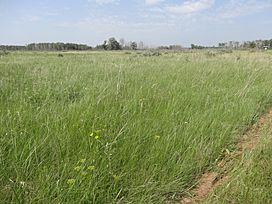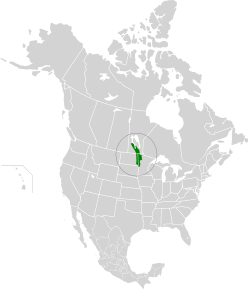Northern tall grasslands facts for kids
Quick facts for kids Northern tall grasslands |
|
|---|---|

Tall grasses of Manitoba Tall Grass Prairie Preserve
|
|
 |
|
| Ecology | |
| Realm | Nearctic |
| Biome | Temperate grasslands, savannas, and shrublands |
| Borders |
List
|
| Bird species | 212 |
| Mammal species | 63 |
| Geography | |
| Area | 76,000 km2 (29,000 sq mi) |
| Countries | United States and Canada |
| States/Provinces | Minnesota, North Dakota and Manitoba |
| Conservation | |
| Conservation status | Critical/Endangered |
| Global 200 | Yes |
| Habitat loss | 88.245% |
| Protected | 4.21% |
The Northern tall grasslands is a special natural area. It is one of many ecoregions around the world. An ecoregion is a large area of land or water that has its own unique mix of plants, animals, and climate.
This ecoregion is mostly found along the Red River Valley. This area stretches across parts of Canada and the United States. You can find it in the Canadian province of Manitoba and the American states of North Dakota and Minnesota.
Contents
Climate in the Grasslands
The Northern tall grasslands have a humid continental climate. This means they have warm, wet summers and very cold winters.
The area usually gets a moderate amount of precipitation, like rain and snow. This is typically between 450 to 700 millimeters each year. Winters are super cold, with average temperatures around -12.5 degrees Celsius. Summers are warm, with average temperatures around 16 degrees Celsius. The average temperature for the whole year is about 2.5 degrees Celsius.
Plants of the Grasslands
This ecoregion is famous for its tall grasses. Some of the main types of grass you'll see here are big bluestem, switchgrass, and Indiangrass. These grasses can grow very tall, sometimes even taller than a person!
In places that are a bit wetter, you might also find some trees. These include trembling aspen and bur oak. These trees add variety to the wide-open grassland scenery.
Animals of the Grasslands
Just like other prairie areas in North America, the Northern tall grasslands used to be home to huge groups of animals. There were many bison and elk roaming freely. These large animals were often hunted by predators like the gray wolf and coyote.
Today, most of the bison, elk, and wolves were gone from this area for a long time. However, bison and wolves are slowly starting to return and recover. Other common animals you can see here now include white-tailed deer, rabbits, and ground squirrels. This ecoregion is also a very important home for many different types of waterfowl, which are birds that live near water.
Protecting the Grasslands
It's very important to protect the Northern tall grasslands. A lot of this special habitat has been lost over time.
Some parts of this ecoregion are now protected areas. One important example is the Manitoba Tall Grass Prairie Preserve. These protected lands help keep the unique plants and animals of the grasslands safe for the future.

